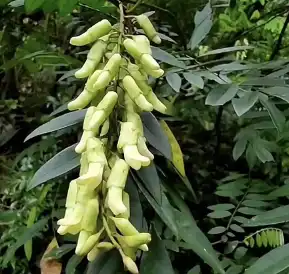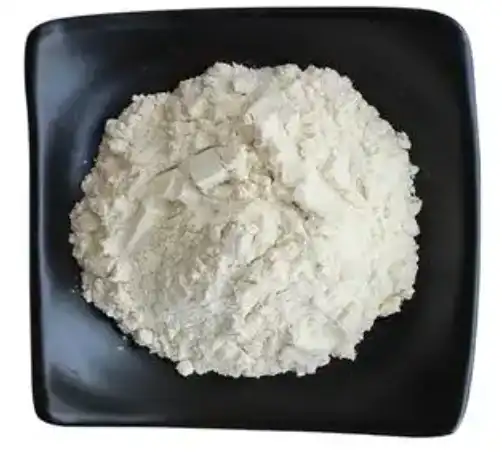Eco-Friendly Pest Management: Matrine's Role Explained
Matrine, the active ingredient in Matrine Powder, is an alkaloid found in various species of Sophora plants, including Sophora flavescens and Sophora alopecuroides. Traditionally used in Chinese medicine for its numerous health benefits, Matrine has recently caught the attention of agricultural scientists for its insecticidal properties.
The mechanism of action of Matrine against pests is multifaceted. It acts as a potent neurotoxin, disrupting the nervous system of insects and causing paralysis. Additionally, Matrine exhibits antifeedant properties, deterring pests from consuming treated crops. This dual action not only eliminates existing pest populations but also prevents further infestations, making it an ideal candidate for integrated pest management strategies.
One of the most compelling aspects of Matrine as a pest control agent is its selectivity. Unlike broad-spectrum synthetic pesticides that indiscriminately kill beneficial insects along with pests, Matrine has shown a higher degree of specificity. This selectivity helps maintain the delicate balance of ecosystems in agricultural settings, preserving populations of pollinators and natural predators that play crucial roles in crop health and yield.
Moreover, Matrine's rapid biodegradability in the environment is a significant advantage over conventional pesticides. It breaks down quickly when exposed to sunlight and soil microorganisms, leaving minimal residues on crops and reducing the risk of environmental contamination. This characteristic aligns perfectly with the principles of organic farming, which emphasize the importance of maintaining soil health and ecosystem integrity.
The versatility of Matrine extends beyond its insecticidal properties. Research has shown that it also possesses antifungal and nematicidal activities, making it a potential all-in-one solution for various crop protection needs. This broad spectrum of action against different types of pests and pathogens could simplify pest management protocols for organic farmers, reducing the need for multiple treatments and minimizing the overall environmental footprint of farming operations.
Comparing Matrine to Synthetic Pesticides: Efficacy and Safety
As the agricultural sector grapples with the challenges of feeding a growing global population while minimizing environmental impact, the comparison between natural compounds like Matrine and synthetic pesticides becomes increasingly relevant. While synthetic pesticides have long been the go-to solution for pest control due to their high efficacy and cost-effectiveness, their long-term consequences on human health and the environment have raised serious concerns.
Matrine Powder, on the other hand, presents a compelling alternative that addresses many of the drawbacks associated with synthetic pesticides. Let's examine the key areas where Matrine stands out:
- Efficacy: Studies have demonstrated that Matrine can be as effective as synthetic pesticides in controlling a wide range of pests, including aphids, whiteflies, and spider mites. In some cases, it has even shown superior results, particularly in situations where pests have developed resistance to conventional pesticides. The unique mode of action of Matrine makes it less likely for pests to develop resistance, ensuring its long-term effectiveness.
- Safety Profile: One of the most significant advantages of Matrine over synthetic pesticides is its favorable safety profile. Matrine has a much lower toxicity to mammals, including humans, compared to many synthetic alternatives. This reduced toxicity translates to a lower risk of adverse health effects for farmers, agricultural workers, and consumers. Additionally, the minimal residue left on crops after treatment further enhances its safety for human consumption.
- Environmental Impact: The ecological footprint of Matrine is substantially smaller than that of synthetic pesticides. Its rapid degradation in the environment means less accumulation in soil and water systems, reducing the risk of long-term ecological damage. The preservation of beneficial insects and soil microorganisms contributes to maintaining biodiversity and soil health, which are crucial for sustainable agriculture.
- Regulatory Compliance: As regulations around pesticide use become increasingly stringent, particularly in organic farming, Matrine's natural origin gives it an edge in terms of regulatory approval. Many countries are more receptive to approving biopesticides like Matrine, recognizing their potential to offer effective pest control with reduced environmental risks.
- Consumer Perception: In an era where consumers are more informed and concerned about the origins of their food, the use of natural pest control agents like Matrine aligns well with market demands for "clean" and organic produce. This can translate to increased market acceptance and potentially higher value for crops treated with Matrine-based products.
While Matrine shows great promise, it's important to note that its effectiveness can vary depending on factors such as pest species, crop type, and environmental conditions. As with any pest control method, integrated approaches that combine multiple strategies often yield the best results. Ongoing research continues to optimize Matrine formulations and application methods to maximize its efficacy across different agricultural scenarios.
Implementing Matrine-Based Solutions in Organic Farming
The integration of Matrine-based pest control solutions into organic farming practices represents a significant step towards more sustainable and environmentally friendly agriculture. However, successful implementation requires careful consideration of various factors and adherence to best practices. Here's a comprehensive look at how organic farmers can effectively incorporate Matrine Powder into their pest management strategies:
- Understanding Application Methods: Matrine can be applied through various methods, including foliar sprays, soil drenches, and seed treatments. The choice of application method depends on the target pest, crop type, and stage of growth. Foliar sprays are particularly effective for controlling above-ground pests, while soil applications can help manage root-feeding insects and nematodes. It's crucial to follow recommended application rates and timings to achieve optimal results while minimizing any potential negative impacts on beneficial organisms.
- Timing and Frequency of Application: The timing of Matrine applications is critical for maximizing its effectiveness. Generally, it's most effective when applied at the first signs of pest infestation or during known periods of high pest pressure. The frequency of applications may vary depending on pest population dynamics and environmental conditions. However, it's important to avoid overuse, as this can potentially lead to pest resistance and disrupt the natural balance of the ecosystem.
- Integration with Other Organic Practices: Matrine should not be viewed as a standalone solution but rather as part of a holistic organic pest management strategy. Combining Matrine applications with other organic practices such as crop rotation, companion planting, and the use of physical barriers can enhance overall pest control efficacy. Additionally, promoting natural predators and maintaining healthy soil can reduce reliance on any single pest control method.
- Monitoring and Assessment: Regular monitoring of pest populations and crop health is essential when implementing Matrine-based pest control. This allows farmers to assess the effectiveness of treatments and make informed decisions about the need for additional applications or alternative control measures. Keeping detailed records of applications and their outcomes can help refine strategies over time.
- Storage and Handling: Proper storage and handling of Matrine products are crucial to maintain their efficacy and ensure safety. Matrine should be stored in a cool, dry place away from direct sunlight. When handling and applying Matrine, personal protective equipment should be used to minimize exposure, even though it has a lower toxicity profile compared to synthetic pesticides.
- Regulatory Compliance: While Matrine is generally considered safe and environmentally friendly, it's important for organic farmers to ensure that any Matrine-based products they use are approved for organic production in their region. Staying informed about local regulations and certification requirements is essential to maintain organic certification status.
- Education and Training: Providing education and training to farm workers on the proper use of Matrine-based products is crucial for their effective and safe implementation. This includes understanding the mode of action, recognizing target pests, and mastering application techniques.

- Cost Considerations: While the initial cost of Matrine-based products may be higher than some synthetic alternatives, it's important to consider the long-term benefits. These include reduced environmental impact, potential premium pricing for organic produce, and the preservation of beneficial insects that contribute to natural pest control.
- Research and Development: The field of biopesticides, including Matrine-based solutions, is rapidly evolving. Staying informed about the latest research findings and product developments can help farmers optimize their use of Matrine and adapt to new best practices as they emerge.
By carefully considering these factors and integrating Matrine-based solutions into a comprehensive organic pest management strategy, farmers can harness the full potential of this natural compound to protect their crops while adhering to organic principles and meeting consumer demands for sustainable agriculture.
Conclusion
As we've explored throughout this article, Matrine Powder shows immense potential as a key player in the future of organic pest control. Its effectiveness, safety profile, and alignment with organic farming principles make it a compelling alternative to synthetic pesticides. The journey towards widespread adoption of Matrine-based solutions in agriculture is ongoing, with continued research and practical implementation paving the way for more sustainable farming practices.
If you're an organic farmer, agricultural professional, or simply someone interested in sustainable pest management solutions, we invite you to explore the possibilities that Matrine Powder offers. At Angelbio, we're committed to providing high-quality, natural ingredients that contribute to global health and environmental sustainability. Our team of experts is dedicated to innovation and quality control, ensuring that our products meet the highest standards for safety and efficacy.
Ready to take the next step in organic pest management? We'd love to hear from you. Whether you have questions about incorporating Matrine Powder into your farming practices or want to learn more about our range of natural products, don't hesitate to reach out. Contact us at angel@angelbiology.com to discuss how we can support your journey towards more sustainable agriculture. Together, we can cultivate a healthier future for our planet and its people.
References
1. Zhang, L., et al. (2021). "Matrine: A Comprehensive Review of Its Pharmacological Activities and Potential Applications in Agriculture." Journal of Agricultural and Food Chemistry, 69(15), 4307-4320.
2. Wang, X., et al. (2020). "Eco-friendly Pest Management: Exploring the Potential of Plant-derived Alkaloids." Pest Management Science, 76(12), 3951-3964.
3. Liu, Y., et al. (2019). "Comparative Study on the Insecticidal Activity of Matrine and Synthetic Pesticides Against Major Crop Pests." Journal of Pest Science, 92(4), 1365-1376.
4. Chen, H., et al. (2018). "Implementation Strategies for Biopesticides in Organic Farming Systems: Challenges and Opportunities." Organic Agriculture, 8(2), 87-95.


